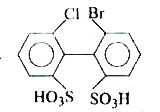Which one of the following complexes shows optical isomerism ?
The correct Answer is:A
To determine which of the given complexes shows optical isomerism, we need to analyze each complex based on the criteria for optical isomerism. Optical isomerism occurs when a molecule has a chiral center, meaning it cannot be superimposed on its mirror image. This typically requires the presence of four different ligands around a central metal atom.
1. Identify the Complexes:
We have four coordination complexes to analyze. Let's denote them as:
- A: (Co(en)₂Cl₂) (cis)
- B: (Co(en)₂Cl₂) (trans)
- C: (Co(NH₃)₄Cl₂)
- D: (Co(NH₃)Cl₃)
2. Analyze Complex A: (Co(en)₂Cl₂) (cis):
- This complex has two bidentate ethylene diamine (en) ligands and two chloride (Cl) ligands.
- The cis arrangement means that the two en ligands are adjacent to each other.
- Since there is no plane of symmetry, this complex can exist in two non-superimposable mirror images (enantiomers).
- Conclusion: Complex A shows optical isomerism.
3. Analyze Complex B: (Co(en)₂Cl₂) (trans):
- This is the trans isomer of the same complex as A.
- In the trans arrangement, the two en ligands are opposite each other.
- There is a plane of symmetry in this structure, meaning it cannot exist in two non-superimposable forms.
- Conclusion: Complex B does not show optical isomerism.
4. Analyze Complex C: (Co(NH₃)₄Cl₂):
- This complex has four ammonia (NH₃) ligands and two chloride (Cl) ligands.
- Regardless of how the ligands are arranged, there will always be a plane of symmetry present due to the arrangement of identical ligands.
- Conclusion: Complex C does not show optical isomerism.
5. Analyze Complex D: (Co(NH₃)Cl₃):
- This complex has three chloride ligands and one ammonia ligand.
- Similar to Complex C, there will be a plane of symmetry present in this arrangement as well.
- Conclusion: Complex D does not show optical isomerism.
Final Answer:
The only complex that shows optical isomerism is Complex A: (Co(en)₂Cl₂) (cis).
We have four coordination complexes to analyze. Let's denote them as:
- A: (Co(en)₂Cl₂) (cis)
- B: (Co(en)₂Cl₂) (trans)
- C: (Co(NH₃)₄Cl₂)
- D: (Co(NH₃)Cl₃)
- This complex has two bidentate ethylene diamine (en) ligands and two chloride (Cl) ligands.
- The cis arrangement means that the two en ligands are adjacent to each other.
- Since there is no plane of symmetry, this complex can exist in two non-superimposable mirror images (enantiomers).
- Conclusion: Complex A shows optical isomerism.
- This is the trans isomer of the same complex as A.
- In the trans arrangement, the two en ligands are opposite each other.
- There is a plane of symmetry in this structure, meaning it cannot exist in two non-superimposable forms.
- Conclusion: Complex B does not show optical isomerism.
- This complex has four ammonia (NH₃) ligands and two chloride (Cl) ligands.
- Regardless of how the ligands are arranged, there will always be a plane of symmetry present due to the arrangement of identical ligands.
- Conclusion: Complex C does not show optical isomerism.
- This complex has three chloride ligands and one ammonia ligand.
- Similar to Complex C, there will be a plane of symmetry present in this arrangement as well.
- Conclusion: Complex D does not show optical isomerism.
The only complex that shows optical isomerism is Complex A: (Co(en)₂Cl₂) (cis).
Topper's Solved these Questions
Similar Questions
Knowledge Check
- Question 1 - Select One
Which of the following compound shows optical isomerism ?
ACH3CH2CH3BCH2OHCHOHCH2OHCCH3CHOHC2H5DNone of these - Question 2 - Select One or More
Which of the following will show optical isomerism?
A B
B C
C D
D
Which of the following compound show optical isomerism?
View SolutionWhich of the following compound show optical isomerism?
View SolutionWhich one of the following can shown optical isomerism ?
View SolutionWhich one of the following compounds show optical activity
View SolutionWhich of the following will show optical isomerism?
View SolutionWhich of the following does not show optical isomerism ?
View Solution
